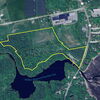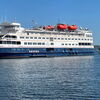
Processing Your Payment
Please do not leave this page until complete. This can take a few moments.
Bank expansion heats up, and Chase’s Maine rollout isn't the only game in town
 Photo / Tim Greenway
Jeanne Hulit, president and CEO of Maine Community Bank, at the bank’s $8 million future operations center and full-service branch in Westbrook.
Photo / Tim Greenway
Jeanne Hulit, president and CEO of Maine Community Bank, at the bank’s $8 million future operations center and full-service branch in Westbrook.
As JPMorgan Chase prepares to enter southern Maine’s crowded retail banking market, rivals are watching but not standing still.
“They’re formidable,” Curtis Simard, president and CEO of Bar Harbor Bank and Trust (with $3.6 billion in assets) says of JPMorgan Chase, the largest U.S. bank with $2.7 trillion in assets. Both opened commercial offices in Portland in 2018, and now the Wall Street behemoth is preparing to open its first retail office there along with four others in Greater Portland by 2022.
“We’ll be watching to make sure they don’t have broader plans than that,” says Simard.

While the time isn’t yet right for his bank to open a retail branch in Portland, Bar Harbor Bank is adding to its physical footprint elsewhere with newly built branches in Brunswick (for $2.4 million) — not far from a Topsham branch it closed — and Bedford, N.H.
The openings come about a year after Bar Harbor Bank bought eight branches from People’s United Bank in a deal that added $287 million in deposits and extended its reach to central Maine and the Bangor area. It’s one of several Maine-based banks adding branches in the state and region as Chase and others do so on a national scale.
While banks regularly reconfigure their retail networks and service offerings, the fact that many are bulking up on branches now is all the more striking given the increase in digital and remote banking during the pandemic. Convinced there’s still a role for in-person services, players big and small are sticking with expansion plans while also investing in technology.
“The bricks and mortar of banking continues to undergo significant change,” says Maine Bankers Association CEO Chris Pinkham. “Every bank is seeking opportunities to expand its customer base.”
Portland’s pull
Maine is notoriously “over-banked,” with most activity in the densely populated south. In the Portland-South Portland area alone, more than 20 institutions hold $18 billion in deposits, according to the latest federal data. Though new players are entering the fragmented market, more than half of deposits are at three national players — TD Bank, Bank of America and KeyBank.


Chase’s push into greater Portland, starting with a leased downtown location due to open in June, comes amid an ongoing drive to operate branches in all 48 lower U.S. states. The plan, unveiled in 2018, calls for opening 400 new branches over five years employing a combined 3,000 people, including 50 in Maine, where its Portland commercial team is led by Michael Griffin.
“As we started market expansion back in 2018, we’ve always had Maine in our sights, so our teams on the ground have been scouring the market for the right opportunity,” says Ashlee Kelly, Chase’s real estate strategic plan director. She says Portland fits the bill because of its size and alignment with Chase’s New England strategy and underscores that its commitment is long-term.

“It certainly takes time for us to become known in the market and for people to understand the value we bring,” she says. “We are here for the long haul.”
As Maine’s largest city, Portland has an equally attractive pull for smaller banks.
They include Skowhegan Savings Bank, which is transforming a former tanning salon in Portland’s East Bayside neighborhood into a commercial banking center — its 11th in the state and first in southern Maine.

“We’re very excited about this location,” says Skowhegan Savings President and CEO David Cyr. Though it had also considered downtown, Cyr says it didn’t feel right, adding: “The East Bayside neighborhood is a good fit for us with such a vibrant community of innovators, creators and makers. Similar to the businesses in East Bayside, our team isn’t afraid to roll up their sleeves and get to work.”
In nearby Westbrook, the newly formed Maine Community Bank is building an $8 million, 23,000-square-foot operations center and full-service branch slated for completion later this year.
Conveniently located halfway between its existing bases in Biddeford and Auburn, the site is near the Rock Row development where Chase will have one of its branches, with a design that pays homage to the mill-town heritage of Biddeford, Lewiston-Auburn and Westbrook. It’s also relocating within Brunswick, with plans to start construction on a bigger branch in the second quarter.

Brunswick was originally a commercial loan office but “ended up growing and having so much business that we need a more full-service retail branch,” says Jeanne Hulit, the bank’s president and CEO. Speaking more generally about what’s driving bank branch expansion, she says: “The net interest margin for banks is very compressed for banks in this interest-rate environment, so the only way you’re going to make it up and keep the bottom line from contracting is through growth.”
Hulit also says that while Chase will be competition for everyone, she is confident that smaller banks like hers will be able to hold their own “because we’re part of the fabric of the communities.”
TD Bank, Bank of America
Among national banks with a long-standing presence in Maine, TD Bank has 44 branches in 35 towns and cities.
“We’re very proud of our rich market share in northern New England, and in particular in Maine, our store platform is an incredibly important part of our strategy,” says Sheryl McQuade, TD Bank’s regional president for northern New England.

“We also focus on our omni-channel distribution strategy” including digital and mobile solutions. “It’s really a robust platform that we continue to evaluate, making sure that we’re everywhere our customers need to be and can access us in the most convenient way.”
BofA, which unveiled a nationwide branch expansion in new and existing markets in 2019, also sees its physical and digital activities as complementary, according to Maine market president Bill Williamson. In Maine, BofA sold 15 branches to Camden National Bank in 2012 and today has 11 branches.
“There was a time when you looked at consumer banking through the eyes of a financial center,” he says. “Now you really have to look at digital and the financial centers together as the delivery system.”
Maine-based big three
The largest Maine-based banks — Bangor Savings, Camden National and Bar Harbor — are all growing through strategic expansion.
Bangor Savings, led by President and CEO Bob Montgomery-Rice since 2015, now has 57 branches in Maine, including five on the Midcoast through a merger with Damariscotta Bank and Trust Co. completed in December; they include two branches in Damariscotta and one each in New Harbor, Union and Warren. It sold a sixth to First Bancorp Inc. in Belfast, where Bangor Savings already had two branches.
Bangor Savings is also building a new branch in Windham, where it already has a strong customer base. In New Hampshire, it has six branches including a new one in Concord as of Jan. 25 and a new location in Manchester set to open in March.
Montgomery-Rice says all three new localities are attractive as small-business hubs.
“We look for small businesses and Main Street marketplaces where we can collectively serve businesses, owners and their employees, and consumers,” he explains. “We’ll continue to evaluate how the pandemic has changed utilization of banks and fill in markets based on what we’ve learned.”

He says that deciding between acquiring branches or building new ones depends on various factors, and notes that Bangor Savings has built more than 20 branches over the last 15 years.
“Over the next several years we’ll be doing more de novo branches,” he predicts.
Camden National has a total of 57 banking centers and branches in Maine and one in Portsmouth, along with a mortgage office in Braintree, Mass.
In March 2020 it opened a new location in Damariscotta to replace a previous location, leasing space in a new building for better access, visibility and more room, according to president and CEO Gregory A. Dufour.
“We view our branches as one of the critical components of our overall delivery network, which also includes our digital capabilities,” he says.
Meanwhile in Downeast Maine, Bar Harbor Bank is up to 52 branches in Maine, Vermont and New Hampshire, including eight purchased from People’s United Bank in 2019 and the new constructs in Brunswick and Bedford.
Simard, who grew up in Saco, says he remains intrigued by Portland but that timing is key, noting, “The question is to do it right and do it well, or don’t do it.”














0 Comments